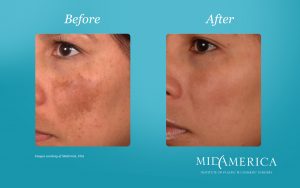Is that a mustache on my face..nope, it’s just Melasma (insert face palm.)
I honestly was naïve and never thought I would suffer from Melasma. I went to school specifically to study and help others with their skin. It’s not supposed to happen to Aestheticians, right? WRONG! 8 months into my pregnancy and BOOM I had to take about 10 double looks in the mirror. Showing up on VERY hormonal women who are pregnant /nursing (which means limited on treatments) is a cruel joke mother nature. Let’s break down why and what we can do to get rid of this “wonderful” new friend of ours, shall we…
Unfortunately for all of us, melanocytes just can’t stop working overtime. Melanin (released by melanocytes) is a key component of our bodies’ defense against sun exposure. This is why darker skin types burn less easily after sun exposure and why lighter skin types are most often affected by skin cancer. However, a newly darkened area on your skin doesn’t always turn out to be melanoma. Melanocytes release melanin when it gets triggered by an enzyme known as Tyrosinase. Melanin-inhibiting ingredients most often attempt to stop this enzyme before it spurs an increase in melanin production.
Here’s the next kicker.. There’s also Melasma’s friend – Hyperpigmentation.
Ok, Do I have Melasma or Hyperpigmentation?
Don’t worry, that’s what we are here for! In general terms, hyperpigmentation refers to uneven darkening of the skin caused by an external stressor, the most common of which is sun exposure. We all want that beautiful Bronze skin but what we don’t realize is a tan is actually sun damage. It’s about to happen for a lot of us: bits of annoying dark spots scattered around our face, chest and tops of hands, which become more prominent as the sun comes out. I have them, and most clients I know deal with some form of pigment annoyance, and if you don’t have them, count your blessings and PREVENT!
When sunlight reaches the skin, it triggers the production of melanin within the lower layers which then travels up to the surface of the skin, resulting in visible dark spots or patches. These dark spots can develop in all shapes, sizes and densities, and can affect all skin types, tones and ethnicities. If it’s not caused directly by UV rays, hyperpigmentation can develop following skin trauma (such as cuts or scrapes that break the skin), blemishes and the use of topical treatments that might be too intensive for your skin type. In order to successfully prevent dark spots and uneven pigmentation from developing, the best advice is to apply a sunscreen every morning before leaving the house, ideally one with an SPF30 or more.*A fan favorite is our– The Spa Daily Tinted Sunshield SPF50 that feels like a BB cream and gives a great hint of color. It works with the melanin in your skin (yes, the same Melanin that gave you that brown spot) to produce a natural glowing color. Using a sunscreen will also prevent hyperpigmentation caused by breakouts or healed injuries from becoming darker.
These dark patches on the skin are called solar lentigines, hyperpigmentation, or less formally, sun spots. These discolorations are not cancerous and do not cause negative effects on your skin health. If you neglect sunscreen or have neglected sunscreen in the past, chances are you have a few of these sun spots on your face, neck and/or hands. People with darker skin tones may experience these solar lentigines as patches of ashy or gray skin. Your Grandma may have referred to them as “liver spots,” but these darker areas have no connection with liver function. Instead, they are mostly the result of sun damage, much like a freckle that appears after a summer in the sun. Occasionally, these darker patches appear on the face and neck as a result of hormonal changes, most often due to pregnancy. They will also appear after cuts and blemishes heal on darker skin.
Treating dark spots and sun damage isn’t easy but as the pigment is mainly found near the surface of the skin, topical products and treatments are the most reliable ways to brighten and correct uneven tone. Look for brightening ingredients like Vitamin C in serums, masks and moisturizers. For more stubborn pigmentation, opt for in-clinic treatments like lasers or peels to help rid the skin of clusters of melanin that your skin care can’t break down by itself.
Symptoms of Melasma
While hyperpigmentation is caused by things affecting the skin from outside the body, melasma develops because of internal changes. When there is an increase in the production of the female hormone estrogen, melanin production goes into overdrive which leads to the development of large patches of darkened skin appearing on the face, usually on the cheeks and upper lip, in an almost symmetrical pattern. This hormonal change can be due to a new type of medication or contraception being ingested by the body, or as the result of pregnancy which is why melasma almost exclusively affects women.
Once you develop melasma, the only way to treat the condition is to manage it as well as possible. That means always using a sunscreen during the day to prevent existing dark patches from worsening and employing a combination of skin care and supplements to suppress and control the amount of melanin produced by the skin. As most of this melanin activity takes place deep within the dermis, treating melasma isn’t easy. However, once your hormones have settled down and a good skin care regime is in place, you can enjoy an even and radiant complexion.
Melasma, literally meaning dark skin, is most commonly known as the “mask of pregnancy,” an area of hyperpigmentation that shows up across the face of more than half of all pregnant women. But you don’t even have to be pregnant (or female) to develop this skin condition. Increased estrogen (from pregnancy, birth control pills, estrogen supplements or other hormone sensitivities) trigger pigment producing cells called melanocytes to produce too much melanin, resulting in patchy skin discolorations. If you develop melasma for whatever reason, the first thing to know is that it is very common and it is completely harmless. Six million U.S. women are affected by the condition, which although not physically harmful can be distressing and embarrassing.
So what do I do?
One of the many reasons why I love working at The Spa at MidAmerica– we are constantly encouraged to seek out the best treatments/products. We take continuing education very seriously and want to be top industry-leading providers in our field. One of our latest purchases/training is the Spectra laser. While it does several different treatments that involved no downtime, It’s the ONLY laser that’s FDA approved to treat Melasma (yesssss!) *This includes a series of treatments spaced out 7-10 days apart. We offer a handful of treatments customized just for your specific needs. It is believed that melasma is caused by estrogen interaction with certain environmental factors. You can prevent and reduce hyperpigmentation using a combination of high quality Vitamin C based products, Antioxidants such as green tea extract and certain peptides at the correct concentrations. SkinCeuticals has a great line for prevention.
Some of the most common ingredients used to lighten or “bleach” the skin affected by melasma or other discolorations include hydroquinone, kojic acid, glycolic acid, vitamin A/retinol/tretinoin, azelaic acid, ascorbic acid, lactic acid, salicylic acid, steroids and sunscreens. A treatment containing hydroquinone above 2%, or tretinoin or azelaic acid over 20% is automatically placed into the prescription category which we offer here and are able to get same day (when in stock.) We also offer several different peel options. VI for example, is great for ALL skin types.
Pregnant or Nursing? We understand! We offer different options that won’t put your baby in harms way and get your skin back to looking like it did before those cruel hormones took over! One of our favorite ‘go to’ products (Phloretin CF) is from our newest Medical grade skin care line, SkinCeuticals.
When to see a Doctor?
We always recommend getting a yearly skin check. It’s hard to see most spots on your body and what looks normal to you, may look suspicious to one of our providers. If you feel that the brown spots are becoming darker or have changed the appearance it is better to see a doctor and get the condition evaluated. Some changes can be signs of melanoma. Things to look out for if the spot:
- Has dark pigmentation
- Is rapidly increasing in size
- Has irregular border
- Has redness, tenderness or bleeding
- Cause itching in the area
Skin care is not one size fits all. I cannot stress this enough! It’s very important to know and understand the difference between Hyperpigmentation and Melasma, along with other skin conditions. That is something only licensed professionals will know. You wouldn’t want your plumber Larry to biopsy your skin growth, right? Exactly.
We are always here (alongside your dermatologist) to help out! Prevention is crucial. Not all dark spots are created equal. Be aware of seasonal differences in skincare and take care of your skin now as it’ll be easier (and cheaper!) than later on. Luckily, really big hats are super cute, and you don’t have to spend your life hiding from the sun! Embrace it. Intelligently.
Call TODAY to schedule your free consult! 618-307-6233



Leave a Reply